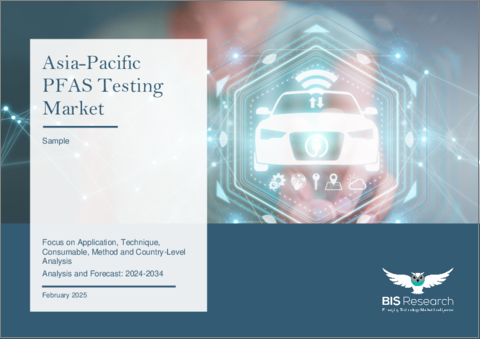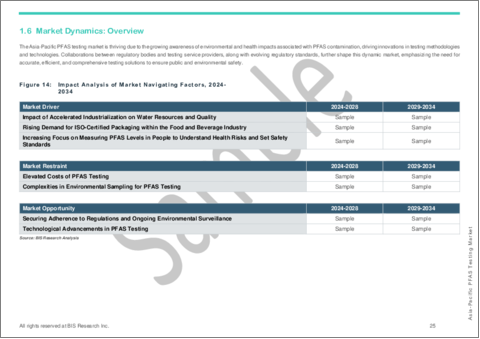|
|
市場調査レポート
商品コード
1661673
アジア太平洋地域のPFAS検査市場:用途・技術・消耗品・手法・国別の分析・予測 (2024-2034年)Asia-Pacific PFAS Testing Market: Focus on Application, Technique, Consumable, Method and Country-Level Analysis - Analysis and Forecast, 2024-2034 |
||||||
カスタマイズ可能
|
|||||||
| アジア太平洋地域のPFAS検査市場:用途・技術・消耗品・手法・国別の分析・予測 (2024-2034年) |
|
出版日: 2025年02月26日
発行: BIS Research
ページ情報: 英文 62 Pages
納期: 1~5営業日
|
- 全表示
- 概要
- 図表
- 目次
アジア太平洋地域のPFAS検査の市場規模は、2024年の6,450万米ドルから、予測期間中はCAGR 10.6%で推移し、2034年には1億7,740万米ドルに達すると予測されています。
同地域のPFAS検査市場の成長は、PFAS汚染に関連する健康リスクと環境リスクに対する意識の高まりによって牽引されています。水、土壌、空気、生物学的サンプルに対する正確な検査ソリューションのニーズは、検出技術の向上だけでなく、地域の規制強化によっても高まっています。このダイナミックな市場は、公共の安全性を向上させながら法的要件の遵守を保証する業界パートナーシップと最先端の分析手法によって形成されています。参入企業は、政府が環境規制を強化し、産業界が信頼できるモニタリングソリューションを求める中、この地域の環境問題の高まりに効果的に対処するため、技術革新と持続可能な検査技術に注力しています。
| 主要市場統計 | |
|---|---|
| 予測期間 | 2024-2034年 |
| 2024年評価 | 6,450万米ドル |
| 2034年予測 | 1億7,740万米ドル |
| CAGR | 10.6% |
アジアにおけるPFAS検査市場は、PFASが人の健康と環境にもたらす危険性に対する認識が高まった結果、大きく拡大しています。規制が厳しくなり、正確な検査ソリューションに対するニーズが高まっているのは、この地域の工業化と都市化が進んだ結果であり、PFAS汚染物質が深刻な懸念となっています。生物学的サンプル、土壌、水、大気中のPFAS濃度を監視・規制するため、アジア太平洋全域の政府が厳しい環境規制を実施している中で、高度な検出技術が必要とされています。
クロマトグラフィーや質量分析などの分析手法の進歩は、PFAS検査の精度と有効性を高めています。市場参入企業、研究機関、規制当局間の強力なパートナーシップも市場の成長を後押ししています。規制構造が変化し続ける中、水処理、製造、ヘルスケアなどのセクターは、コンプライアンスを確保し環境リスクを軽減するために高精度試験に投資しています。
市場はまた、費用対効果が高く環境に優しい手法を重視し、持続可能な検査ソリューションへと移行しています。包括的なPFAS試験への需要が高まり続ける中、市場参入企業はこの地域の環境課題に効果的に対処するため、技術的進歩を優先しています。同地域のPFAS試験市場は、このような継続的な開発により、持続的な拡大と技術革新に適した位置にあります。
当レポートでは、アジア太平洋地域のPFAS検査の市場を調査し、主要動向、市場影響因子の分析、法規制環境、技術開発・特許の動向、ケーススタディ、市場規模の推移・予測、各種区分・主要国別の詳細分析、競合情勢、主要企業のプロファイルなどをまとめています。
市場の分類
セグメンテーション1:用途別
- 飲料水
- 廃水
- 土壌
- 食品飲料
- 空気
- 血清・血液
- その他
セグメンテーション2:技術別
- タンデム質量分析付き液体クロマトグラフィー (LS-MS-MS)
- ガスクロマトグラフィー質量分析 (GC-MS)
- 核磁気共鳴分光法
- 燃焼イオンクロマトグラフィー
- 酵素結合免疫吸着測定法
- 質量分析
- その他
セグメンテーション3:消耗品別
- サンプル調製製品
- クロマトグラフィーカラム
- 標準物質・分析基準物質
- 溶媒
- メンブレンフィルター・シリンジフィルター
- 試薬
- その他
セグメンテーション4:手法別
- EPA
- DIN
- ISO
- ASTM
- その他
セグメンテーション5:地域別
- 中国、日本、インド、その他
目次
エグゼクティブサマリー
範囲と定義
第1章 市場
- PFAS検査市場:現在と将来
- 健康上の利点を理由に植物由来食品の採用が増加
- 都市化の進行と耕作地の減少
- サプライチェーンの概要
- バリューチェーン分析
- 価格分析
- 研究開発レビュー
- 特許出願動向 (国別・企業別)
- 規制状況
- PFAS禁止シナリオ
- 試験要件と規制
- 今後の政策変更と勧告
- ステークホルダー分析
- 政府機関
- 試験機関
- 影響分析
- 市場力学:概要
- 市場促進要因
- 市場抑制要因
- 市場機会
第2章 地域
- PFAS検査市場 (地域別)
- アジア太平洋
- 市場
- 用途
- 製品
- アジア太平洋 (国別)
第3章 市場:競合ベンチマーキングと企業プロファイル
- 次なるフロンティア
- 競合ベンチマーキング
- 企業プロファイル
- Shimadzu Corporation
第4章 調査手法
List of Figures
- Figure 1: Asia-Pacific PFAS Testing Market (by Scenario), $Billion, 2023, 2027, and 2034
- Figure 2: PFAS Testing Market (by Region), $Million, 2023, 2027, and 2034
- Figure 3: Asia-Pacific PFAS Testing Market (by Application), $Million, 2023, 2027, and 2034
- Figure 4: Asia-Pacific PFAS Testing Market (by Technique), $Million, 2023, 2027, and 2034
- Figure 5: Asia-Pacific PFAS Testing Market (by Consumable), $Million, 2023, 2027, and 2034
- Figure 6: Asia-Pacific PFAS Testing Market (by Method), $Million, 2023, 2027, and 2034
- Figure 7: Key Events
- Figure 8: Rise in Per Capita Plant-Based Protein Consumption in Grams, 2018-2021
- Figure 9: Urbanization Rate, 2021-2023
- Figure 10: Supply Chain and Risks within the Supply Chain
- Figure 11: Value Chain Analysis
- Figure 12: Patent Analysis (by Country), January 2021-July 2024
- Figure 13: Patent Analysis (by Company), January 2021-July 2024
- Figure 14: Impact Analysis of Market Navigating Factors, 2024-2034
- Figure 15: Number of Cancer Cases by PFAS, 2022
- Figure 16: China PFAS Testing Market, $Million, 2023-2034
- Figure 17: Japan PFAS Testing Market, $Million, 2023-2034
- Figure 18: India PFAS Testing Market, $Million, 2023-2034
- Figure 19: Rest-of-Asia-Pacific PFAS Testing Market, $Million, 2023-2034
- Figure 20: Strategic Initiatives, 2020-January 2024
- Figure 21: Share of Strategic Initiatives, January 2020-January 2024
- Figure 22: Data Triangulation
- Figure 23: Top-Down and Bottom-Up Approach
- Figure 24: Assumptions and Limitations
List of Tables
- Table 1: Market Snapshot
- Table 2: Opportunities across Region
- Table 3: Competitive Landscape Snapshot
- Table 4: Trends: Overview
- Table 5: Pricing Analysis of Various PFAS Testing Techniques
- Table 6: Regulatory Landscape for PFAS Ban Scenario
- Table 7: Regulatory Landscape for Testing Requirements and Regulations
- Table 8: Regulatory Landscape for Future Policy Changes and Recommendations
- Table 9: List of Government Agencies with Locations and Descriptions
- Table 10: List of Testing Organizations and Institutions with Locations and Descriptions
- Table 11: PFAS Testing Market (by Region), $Million, 2023-2034
- Table 12: Asia-Pacific PFAS Testing Market (by Application), $Million, 2023-2034
- Table 13: Asia-Pacific PFAS Testing Market (by Technique), $Million, 2023-2034
- Table 14: Asia-Pacific PFAS Testing Market (by Consumable), $Million, 2023-2034
- Table 15: Asia-Pacific PFAS Testing Market (by Method), $Million, 2023-2034
- Table 16: China PFAS Testing Market (by Application), $Million, 2023-2034
- Table 17: China PFAS Testing Market (by Technique), $Million, 2023-2034
- Table 18: China PFAS Testing Market (by Consumable), $Million, 2023-2034
- Table 19: China PFAS Testing Market (by Method), $Million, 2023-2034
- Table 20: Japan PFAS Testing Market (by Application), $Million, 2023-2034
- Table 21: Japan PFAS Testing Market (by Technique), $Million, 2023-2034
- Table 22: Japan PFAS Testing Market (by Consumable), $Million, 2023-2034
- Table 23: Japan PFAS Testing Market (by Method), $Million, 2023-2034
- Table 24: India PFAS Testing Market (by Application), $Million, 2023-2034
- Table 25: India PFAS Testing Market (by Technique), $Million, 2023-2034
- Table 26: India PFAS Testing Market (by Consumable), $Million, 2023-2034
- Table 27: India PFAS Testing Market (by Method), $Million, 2023-2034
- Table 28: Rest-of-Asia-Pacific PFAS Testing Market (by Application), $Million, 2023-2034
- Table 29: Rest-of-Asia-Pacific PFAS Testing Market (by Technique), $Million, 2023-2034
- Table 30: Rest-of-Asia-Pacific PFAS Testing Market (by Consumable), $Million, 2023-2034
- Table 31: Rest-of-Asia-Pacific PFAS Testing Market (by Method), $Million, 2023-2034
- Table 32: Market Share, 2023
Introduction to Asia-Pacific PFAS Testing Market
The Asia-Pacific PFAS testing market was valued at $64.5 million in 2024, and it is expected to grow at a CAGR of 10.6% and reach $177.4 million by 2034. The growth of the APAC PFAS Testing Market is being driven by growing awareness of the health and environmental risks associated with PFAS contamination. The need for accurate testing solutions for water, soil, air, and biological samples is being driven by stricter regional regulations as well as improvements in detection technologies. This dynamic market is being shaped by industry partnerships and state-of-the-art analytical methods, which guarantee adherence to legal requirements while improving public safety. Market participants are concentrating on innovation and sustainable testing techniques to effectively address the region's growing environmental concerns as governments tighten environmental regulations and industries look for dependable monitoring solutions.
Market Introduction
| KEY MARKET STATISTICS | |
|---|---|
| Forecast Period | 2024 - 2034 |
| 2024 Evaluation | $64.5 Million |
| 2034 Forecast | $177.4 Million |
| CAGR | 10.6% |
The market for PFAS testing in Asia is expanding significantly as a result of growing awareness of the dangers that perfluoroalkyl substances (PFAS) pose to human health and the environment. Stricter regulations and an increasing need for accurate testing solutions are the results of the region's growing industrialization and urbanization, which is making PFAS pollutants a serious concern. Advanced detection technologies are required as a result of strict environmental regulations being implemented by governments throughout Asia-Pacific to monitor and regulate PFAS levels in biological samples, soil, water, and air.
Advances in analytical methods, such as chromatography and mass spectrometry, are increasing the precision and effectiveness of PFAS testing. Strong partnerships between industry participants, research institutes, and regulatory agencies are also encouraging market growth. As regulatory structures keep changing, sectors like water treatment, manufacturing, and healthcare are investing in high-precision testing to ensure compliance and mitigate environmental risks.
The market is also moving toward sustainable testing solutions, with a greater emphasis on cost-effective and environmentally friendly methodologies. As demand for comprehensive PFAS testing continues to rise, market participants are prioritizing technological advancements to address the region's environmental challenges effectively. The APAC PFAS testing market is well-positioned for sustained expansion and innovation thanks to this continuous development.
Market Segmentation
Segmentation 1: by Application
- Drinking Water
- Waste Water
- Soil
- Food and Beverages
- Air
- Serum/Blood
- Others
Segmentation 2: by Technique
- Liquid Chromatography with Tandem Mass Spectrometry (LS-MS-MS)
- Gas Chromatography-Mass Spectrometry (GC-MS)
- Nuclear Magnetic Resonance Spectroscopy
- Combustion Ion Chromatography
- Enzyme-Linked Immunosorbent Assay
- Mass Spectrometry
- Others
Segmentation 3: by Consumable
- Sample Preparation Products
- Chromatography Columns
- Reference Materials and Analytical Standards
- Solvents
- Membrane and Syringe Filters
- Reagents
- Others
Segmentation 4: by Method
- EPA
- DIN
- ISO
- ASTM
- Others
Segmentation 5: by Region
- Asia-Pacific: China, Japan, India, and Rest-of-Asia-Pacific
How can this report add value to an organization?
Product/Innovation Strategy: The product segment helps the reader understand the different applications of the automotive sensor products available based on application (drinking water, waste water, soil, food and beverages, air, serum/blood, and others), technique liquid chromatography with tandem mass spectrometry (LS-MS-MS), gas chromatography-mass spectrometry (GC-MS), nuclear magnetic resonance spectroscopy, combustion ion chromatography, enzyme-linked immunosorbent assay, mass spectrometry, and others), consumable (sample preparation products, chromatography columns, reference materials and analytical standards, solvents, membrane and syringe filters, reagents, and others), method (EPA, DIN, ISO, ASTM, and others). The market is poised for significant expansion with ongoing technological advancements, increased investments, and growing awareness of the importance of PFAS testing. Therefore, the PFAS testing business is a high-investment and high-revenue generating model.
Growth/Marketing Strategy: The Asia-Pacific PFAS testing market has been growing at a rapid pace. The market offers enormous opportunities for existing and emerging market players. Some of the strategies covered in this segment are mergers and acquisitions, product launches, partnerships and collaborations, business expansions, and investments. The strategies preferred by companies to maintain and strengthen their market position primarily include product development.
Competitive Strategy: The key players in the Asia-Pacific PFAS testing market analyzed and profiled in the study include PFAS testing providers. Additionally, a comprehensive competitive landscape such as partnerships, agreements, and collaborations are expected to aid the reader in understanding the untapped revenue pockets in the market.
Table of Contents
Executive Summary
Scope and Definition
1 Markets
- 1.1 PFAS Testing Market: Current and Future
- 1.1.1 Increasing Adoption of Plant-Based Foods for Health Benefits
- 1.1.2 Increasing Urbanization and Diminishing Arable Land
- 1.2 Supply Chain Overview
- 1.2.1 Value Chain Analysis
- 1.2.2 Pricing Analysis
- 1.3 Research and Development Review
- 1.3.1 Patent Filing Trend (by Country and Company)
- 1.4 Regulatory Landscape
- 1.4.1 PFAS Ban Scenario
- 1.4.2 Testing Requirements and Regulations
- 1.4.3 Future Policy Changes and Recommendations
- 1.5 Stakeholder Analysis
- 1.5.1 Government Agencies
- 1.5.2 Testing Organizations and Institutions
- 1.5.3 Impact Analysis
- 1.6 Market Dynamics: Overview
- 1.6.1 Market Drivers
- 1.6.1.1 Rising Demand for ISO-Certified Packaging within the Food and Beverage Industry
- 1.6.1.2 Increasing Focus on Measuring PFAS Levels in People to Understand Health Risks and Set Safety Standards
- 1.6.2 Market Restraints
- 1.6.2.1 Elevated Costs of PFAS Testing
- 1.6.2.2 Complexities in Environmental Sampling for PFAS Testing
- 1.6.3 Market Opportunities
- 1.6.3.1 Securing Adherence to Regulations and Ongoing Environmental Surveillance
- 1.6.3.2 Technological Advancements in PFAS Testing
- 1.6.1 Market Drivers
2 Regions
- 2.1 PFAS Testing Market (by Region)
- 2.2 Asia-Pacific
- 2.2.1 Market
- 2.2.1.1 Key Market Participants in Asia-Pacific
- 2.2.1.2 Business Drivers
- 2.2.1.3 Business Challenges
- 2.2.2 Application
- 2.2.3 Product
- 2.2.4 Asia-Pacific (by Country)
- 2.2.4.1 China
- 2.2.4.2 Japan
- 2.2.4.3 India
- 2.2.4.4 Rest-of-Asia-Pacific
- 2.2.1 Market
3 Markets- Competitive Benchmarking and Companies Profiled
- 3.1 Next Frontiers
- 3.2 Competitive Benchmarking
- 3.3 Company Profiles
- 3.3.1 Shimadzu Corporation
- 3.3.1.1 Overview
- 3.3.1.2 Top Products/Product Portfolio
- 3.3.1.3 Top Competitors
- 3.3.1.4 End-Use Applications
- 3.3.1.5 Key Personnel
- 3.3.1.6 Analyst View
- 3.3.1.7 Market Share, 2023
- 3.3.1 Shimadzu Corporation
4 Research Methodology
- 4.1 Data Sources
- 4.1.1 Primary Data Sources
- 4.1.2 Secondary Data Sources
- 4.1.3 Data Triangulation
- 4.2 Market Estimation and Forecast






